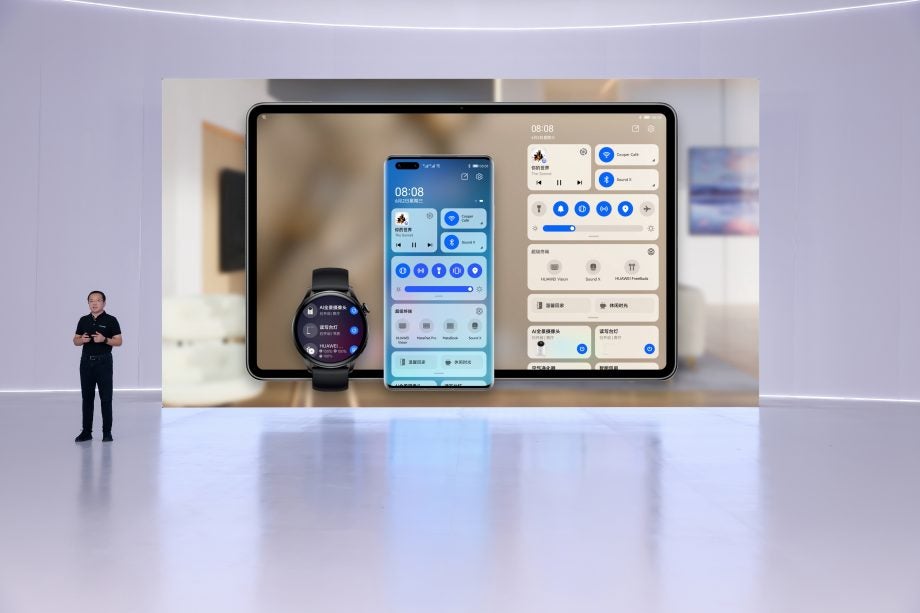What is Huawei HarmonyOS and can I use it on my devices?

Huawei took to the stage back in 2021 to not only announce hardware like the Huawei Watch 3 and MatePad Pro tablet but the long-awaited reveal of Huawei’s Android alternative, HarmonyOS.
Huawei first announced it would be developing its own mobile operating system back in 2019, after the White House banned the Chinese company from using the full Android OS or any other Google services due to security concerns.
The latest release is actually HarmonyOS 2, as Huawei previously launched HarmonyOS 1 as a smart TV OS a few years back, with the latest update available on over 100 Huawei devices – if you’re based in China, anyway.
The rest of us around the world are stuck on EMUI 12 with recent devices like Huawei’s top-end P50 Pro, software that’s based on the ageing Android 11. Will that change in the near future as Huawei continues to push its Android alternative? Well… Probably not.
Here’s everything you need to know about Huawei’s new operating system, HarmonyOS, including key features and if/when we should expect it to hit Huawei smartphones, tablets and wearables in the Western world.
What is Huawei HarmonyOS?
HarmonyOS is a new operating system by Huawei, designed to stand as an alternative to iOS 16 and Android 13. It’s totally separate from Google’s take on Android, though there are similarities as Huawei’s new OS is actually based on the open-source version of Android.
It was first unveiled by Richard Yu, CEO of Huawei’s Consumer Business Group, at the company’s Developer Conference in China on August 9, 2019, and entered into its 2.0 developer beta for smartphones in December 2020, before finally launching for consumers in June 2021.

HarmonyOS isn’t just for smartphones, though. Much of Huawei’s messaging around HarmonyOS 2 focuses on how the operating system is able to connect a wide range of smart devices seamlessly, merging them into what Huawei calls “Super Devices” you can command through its Control Panel. But, more on that below.
What features and apps does HarmonyOS have?
The Control Panel and the Task Center are two of the biggest features we got a closer look at during the announcement event, though there are plenty of other features that make HarmonyOS what it is.
At the event, Huawei described the Control Panel as “a portal for consumers to create Super Devices”. The panel features a drag-and-integrate feature that makes it easy to connect to other smart devices with one swipe.
One example Huawei shared was dragging the smart screen icon to the phone icon to switch a movie over to your TV, or dragging the earbud icon to the phone icon to move the TV audio to your FreeBuds when your family goes to bed.

The Task Center, meanwhile, lets you move apps between different devices without needing to install them on every individual device. You can also view which apps are running on other devices in your Super Device system with the Task Center. You can then drag them over to your tablet or PC for a larger screen or move onto your phone to take your apps on the go.
Then there’s the Home Screen. Like Android and iOS, the Home Screen features widgets which can show information without you opening the app. You can also move the widgets around, change their size and hide them.

For non-Huawei devices, there’s also HarmonyOS Connect. This feature allows you to link your Huawei phone with your smart home appliances with a tap. For example, you can connect your smart oven to see recipes and switch the oven on or connect to your smart refrigerator to adjust the temperature automatically based on the food in your fridge.
HarmonyOS also features multi-device collaborative identity authentication, meaning users can boost their security by choosing to unlock their phone with facial recognition and a separate check on their smartwatch.
According to Huawei, the performance of HarmonyOS is “superior to that of the Android-based EUMI”.
A phone running HarmonyOS can apparently maintain read/write speeds close to those of a new phone after 36 months of use, even with less storage available.

So, what about apps?
Yu previously stated that Huawei hopes to differentiate itself from the competing Android and iOS mobile operating systems by making it easier for developers to create single apps that work across every device category covered by HarmonyOS.
“HarmonyOS is completely different from Android and iOS. It is a microkernel-based, distributed OS that delivers a smooth experience across all scenarios. It has trustworthy and secure architecture, and it supports seamless collaboration across devices. You can develop your apps once, then flexibly deploy them across a range of different devices”, he explained.
Which devices run Huawei HarmonyOS?
Over 100 Huawei devices run HarmonyOS 2 in China including the Mate 40 series, the Mate 30 series, the P40 series, the P50 series, the Mate X2 and Xs 2, the Nova 8 series and the MatePad Pro series.
When will HarmonyOS be rolled out to the UK and Europe?
There’s no word on when or on what devices HarmonyOS will be available in the UK just yet, but given Huawei’s focus on a China-only rollout for now, it’s safe to assume any potential worldwide rollout is quite some time away.


